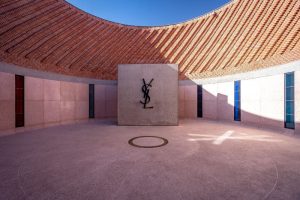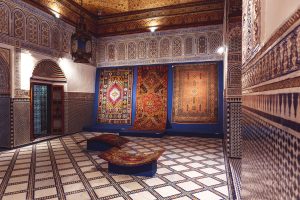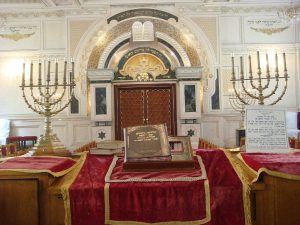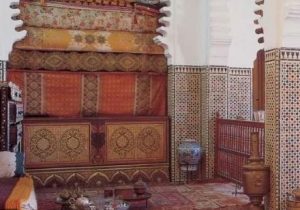
Best Museums in Morocco
You will not regret visiting Morocco if you are a fan of the culture. If you are visiting Marrakech, Fes, Meknes, and Chefchaouen, you are sure to find something to pique your curiosity every time you visit. As a result, they offer a wide range of distinctive customs, plenty of artwork, and tempting accommodations in traditional riads. A lot of the interesting places to visit have literary associations, and there are also many beautiful buildings to admire. Read our article to find out more about the many museums in Morocco and to see a variety of items that will help you get a better understanding of the nation.
- Musée Yves Saint Laurent Marrakech
 The Yves Saint Laurent Museum is a museum dedicated to the fashion designer Yves Saint Laurent located in Marrakesh, Morocco. The Yves Saint Laurent museum was inaugurated in Marrakech after having been under construction for three years. This was in honor of the influential French couturier who was inspired by the colors of Morocco during his early years. Since this country had such a profound influence on the work of this great artist of the twentieth century, it was only natural that a museum displaying the Foundation's collection should be established there. The museum is not only aimed at attracting fashion and art fans, but they are also targeting a wide audience who are eager to discover the world of YSL's work and are eager to discover more about its history.
The Yves Saint Laurent Museum is a museum dedicated to the fashion designer Yves Saint Laurent located in Marrakesh, Morocco. The Yves Saint Laurent museum was inaugurated in Marrakech after having been under construction for three years. This was in honor of the influential French couturier who was inspired by the colors of Morocco during his early years. Since this country had such a profound influence on the work of this great artist of the twentieth century, it was only natural that a museum displaying the Foundation's collection should be established there. The museum is not only aimed at attracting fashion and art fans, but they are also targeting a wide audience who are eager to discover the world of YSL's work and are eager to discover more about its history.
- Dar Si Said Museum
 It is located in Marrakech and was built in the early nineteenth century by a wealthy family. After going through a number of owners, it eventually fell into disrepair, but restoration work began in the 1980s. Dar Si Said Museum is now home to an incredible collection of Moroccan art. Among many things they have stunning collection of Moroccan carpets. There is also a stunning collection of Moroccan jewelry, including traditional Berber jewelry. Many of the items on display were donated by wealthy Moroccans, including a collection of Moroccan artifacts.
It is located in Marrakech and was built in the early nineteenth century by a wealthy family. After going through a number of owners, it eventually fell into disrepair, but restoration work began in the 1980s. Dar Si Said Museum is now home to an incredible collection of Moroccan art. Among many things they have stunning collection of Moroccan carpets. There is also a stunning collection of Moroccan jewelry, including traditional Berber jewelry. Many of the items on display were donated by wealthy Moroccans, including a collection of Moroccan artifacts.
- Museum of Moroccan Arts
 It is located in Rabat and is home to a variety of exhibits that explore the country’s culture and history. If you are interested in learning more about Morocco’s culture and history, this museum will help you explore it. There is also a collection of traditional clothing, including traditional Moroccan costume. Among the exhibits that explore Moroccan culture and society, there is also a fascinating section that looks at Moroccan desserts. Additionally, the museum exhibits a wide range of textiles and tile work, leather goods, intriguing pieces of Moroccan jewelry, Moroccan brass and copper objects, and rural earthenware and crockery that were used in the countryside. It also has a small collection of traditional Moroccan clothing. The museum is also home to a beautiful collection of paintings, including traditional Moroccan paintings, which you definitely do not want to miss.
It is located in Rabat and is home to a variety of exhibits that explore the country’s culture and history. If you are interested in learning more about Morocco’s culture and history, this museum will help you explore it. There is also a collection of traditional clothing, including traditional Moroccan costume. Among the exhibits that explore Moroccan culture and society, there is also a fascinating section that looks at Moroccan desserts. Additionally, the museum exhibits a wide range of textiles and tile work, leather goods, intriguing pieces of Moroccan jewelry, Moroccan brass and copper objects, and rural earthenware and crockery that were used in the countryside. It also has a small collection of traditional Moroccan clothing. The museum is also home to a beautiful collection of paintings, including traditional Moroccan paintings, which you definitely do not want to miss.
- The Museum of Moroccan Judaism.
 It is located in Casablanca and is home to a few important artifacts. Among the items on display are several ancient Torah scrolls, as well as several religious books. There was a chirping of birds in nearby gardens as we explored the wonderful Moroccan Jewish handicrafts that were discovered in the vicinity. It is a very pleasant part of the visit! The exhibition includes 19th-century silver bracelets and fibulae, pendants, amulets, and anklets, as well as dolls dressed in Judeo-Moroccan garb and displayed in a showcase. A much larger area is devoted to sacred art, which includes Megillah cases, Thoras with their embroidered mantles, as well as pieces of furniture from Synagogues. There is also a beautiful needlework of Azemmour from the seventeenth century that can be viewed in the display. It is a fascinating place to explore a rich and varied collection of artifacts in a relaxing environment.
It is located in Casablanca and is home to a few important artifacts. Among the items on display are several ancient Torah scrolls, as well as several religious books. There was a chirping of birds in nearby gardens as we explored the wonderful Moroccan Jewish handicrafts that were discovered in the vicinity. It is a very pleasant part of the visit! The exhibition includes 19th-century silver bracelets and fibulae, pendants, amulets, and anklets, as well as dolls dressed in Judeo-Moroccan garb and displayed in a showcase. A much larger area is devoted to sacred art, which includes Megillah cases, Thoras with their embroidered mantles, as well as pieces of furniture from Synagogues. There is also a beautiful needlework of Azemmour from the seventeenth century that can be viewed in the display. It is a fascinating place to explore a rich and varied collection of artifacts in a relaxing environment.
- The Ethnographic Museum
 It is located in Tetouan. It explores Morocco’s history, and it is home to 5,000 different exhibits. It also houses a fascinating collection of traditional Moroccan instruments, including Berber drums, antique Moroccan instruments, and native flutes. There is also a small collection of traditional Berber jewelry, including bracelets and earrings. The Ethnographic Museum also has a few interesting pieces of clothing, including a traditional djellaba, a red and white turban, and a fouta.
It is located in Tetouan. It explores Morocco’s history, and it is home to 5,000 different exhibits. It also houses a fascinating collection of traditional Moroccan instruments, including Berber drums, antique Moroccan instruments, and native flutes. There is also a small collection of traditional Berber jewelry, including bracelets and earrings. The Ethnographic Museum also has a few interesting pieces of clothing, including a traditional djellaba, a red and white turban, and a fouta.
